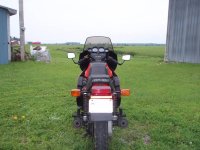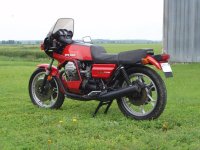DanPez
Cruisin' Guzzisti
I'm looking at the Lemans II first and second series production bikes information and came up with this:
"The CX 100 version sold in the US - 1000cc with downrated carbs - carried a new frame number sequence beginning at VU11111, with only 353 being made in total "
Would anyone know if all 353 CX100 had Guzzi patented Nigusil-plated cylinders or they were mixed with cast-iron /chrome-plated .......and would have to rely on the engine number VE80390 onwards?
Thanks
Update: Per bible VE80390 onwards was for Le Mans II (850cc) not CX100s
"The CX 100 version sold in the US - 1000cc with downrated carbs - carried a new frame number sequence beginning at VU11111, with only 353 being made in total "
Would anyone know if all 353 CX100 had Guzzi patented Nigusil-plated cylinders or they were mixed with cast-iron /chrome-plated .......and would have to rely on the engine number VE80390 onwards?
Thanks
Update: Per bible VE80390 onwards was for Le Mans II (850cc) not CX100s


